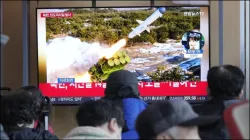North Korea fires multiple ballistic missiles into sea as US-South Korea military drills conclude
Japanese Prime Minister Fumio Kishida and South Korea's Joint Chiefs of Staff condemned North Korea's ballistic missile testing in the wake of US-South Korean military drills. Tensions between the two Koreas are at their highest as Kim Jong Un rejected reunification with the South.

Pyongyang: North Korea on Monday morning fired multiple short-range ballistic missiles as part of its renewed weapons test, according to its neighbours Japan and South Korea, raising tensions after the conclusion of US-South Korean military drills viewed by Pyongyang as an invasion rehearsal. The launches were North Korea's first known missile testing activities in about a month.
Experts predicted earlier that North Korea would extend its run of missile tests and intensify its warlike rhetoric ahead of the US presidential election in November to boost its leverage in future diplomacy. Japan's Defence Ministry said North Korea fired three missiles, two together at 7:44 am (local time) and the other about 37 minutes later.
Japanese Prime Minister Fumio Kishida told a parliamentary session that the North Korean missiles landed in the waters between the Korean Peninsula and Japan, all outside of Japan's exclusive economic zone, and that no damage or injuries have been reported. Kishida denounced North Korea's ballistic missile tests as acts "that threaten the peace and safety of Japan, the region and the international society" and accused Pyongyang of violating UN Security Council resolutions.
South Korea's military said it also detected "several" suspected short-range ballistic launches by North Korea on Monday morning. The Joint Chiefs of Staff called the launches "clear provocation" that threatened peace on the Korean Peninsula. It said South Korea will maintain readiness to repel any provocation by North Korea, based on its solid military alliance with the United States.
War preparations by North Korea
Meanwhile, the US State Department condemned the launches, saying they pose a threat to the North's neighbours and undermine regional security. A State Department statement said the US commitment to the defence of South Korea and Japan remains "ironclad".
It is important to mention here that North Korea fired the ballistic missiles as US Secretary of State Antony Blinken visited Seoul for a conference hosted by President Yoon Suk Yeol on advancing democracy. North Korea's military has been conducting exercises using conventional weapons in recent weeks, often personally overseen by the isolated state's leader, Kim Jong Un.
The US stations a total of 80,000 troops in South Korea and Japan, the backbone of its military presence in the Asia-Pacific region. During the South Korea-US joint military drills that ended on Thursday, North Korean leader Kim Jong Un guided a series of military training exercises involving tanks, artillery guns and paratroopers and called for greater warfighting capabilities.
The 11-day South Korean-US drills involved a computer-simulated command post training and 48 kinds of field exercises, twice the number conducted last year. Although the North did not perform any missile tests during the period, it condemned the military drills and has been pushing hard to mount nuclear warheads on its missiles targeting the US mainland.
Many experts say North Korea already has nuclear-armed missiles capable of reaching all of South Korea and Japan, but it has yet to have functioning long-range missiles that can strike the US mainland. Before Monday's launches, North Korea last carried out missile tests in mid-February by firing cruise missiles into the sea.
Tensions in the Korean Peninsula
North Korea's barrage of missile tests since 2022 has increased tensions in the Korean Peninsula, with several tests involving nuclear-capable missiles designed to attack South Korea and the US. The forces of the two allied countries have responded by expanding their training exercises and trilateral drills involving Japan.
Experts say North Korea likely believes a bigger weapons arsenal would increase its leverage in future diplomacy with the United States. They say North Korea would want to win extensive sanctions relief while maintaining its nuclear weapons.
While North Korean cruise missile activities aren't directly banned under UN sanctions, experts say those weapons potentially pose a serious threat to South Korea and Japan. They are designed to be harder to detect by radar, and North Korea claims they are nuclear-capable and their range is up to 2,000 km, a distance that would include US military bases in Japan.
(with inputs from agencies)
ALSO READ | Dressed in leather jacket, North Korea's Kim Jong Un 'drives' new tank during mock battle | WATCH